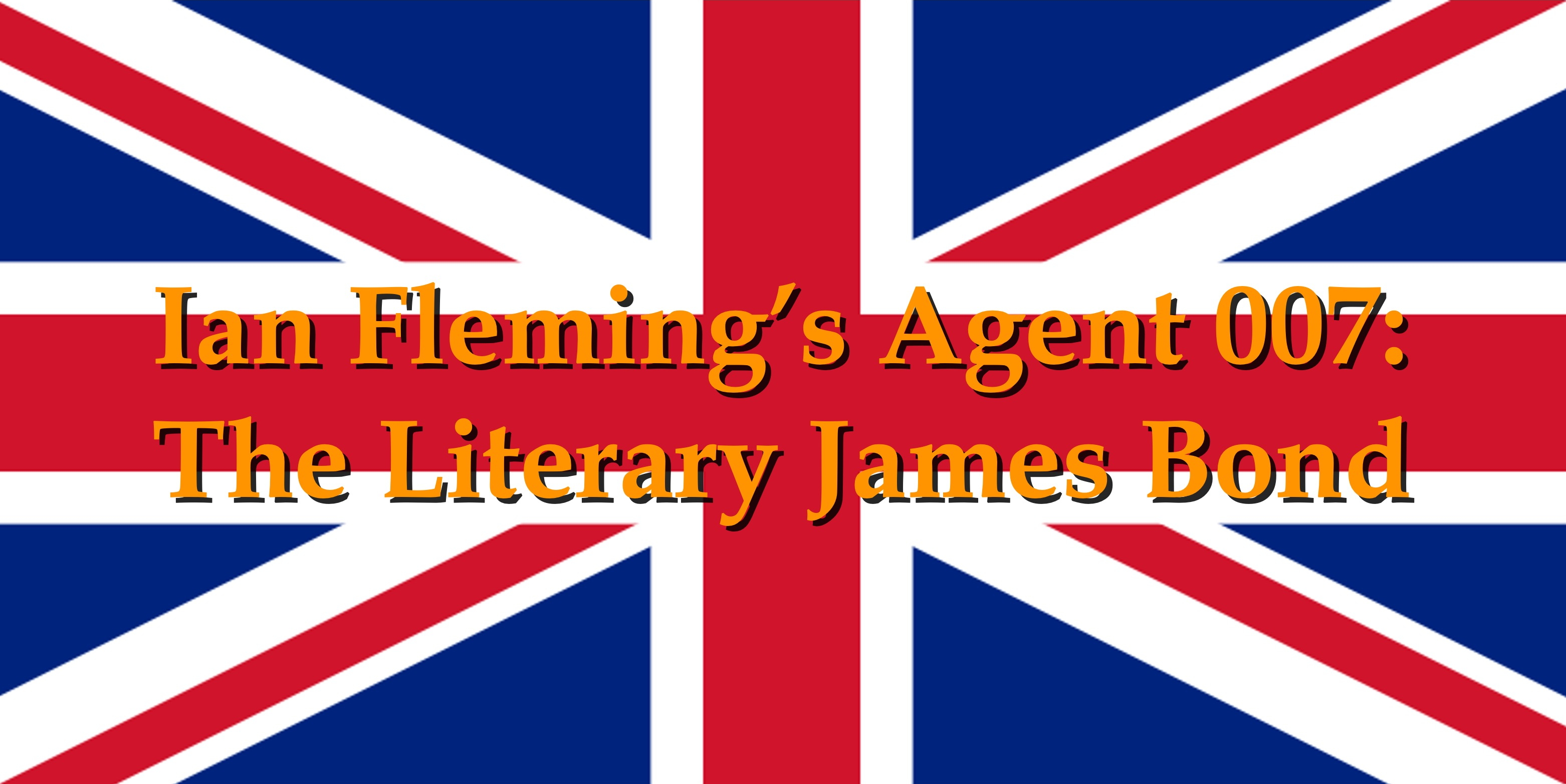

|
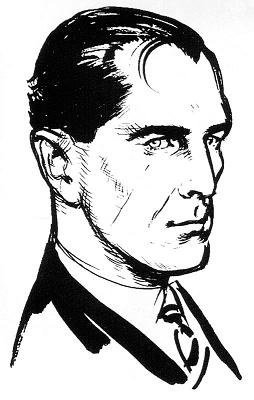


|
Ian Fleming's Agent 007:
|
007 Dossier: A Brief History of James Bond"...the face a taciturn mask; ironical, brutal and cold."With these words, Ian Fleming describes the relaxed sleeping face of his secret agent once the "warmth of the eyes" is extinguished. Although always judged to be "very handsome" by women, Bond is no perfectly groomed pretty boy. He has a fine, three inch long, vertical scar down his right cheek, giving him a faintly "piratical" look, and a perpetual "comma of black hair" hanging over his right eyebrow. (In the immediate post-war era, a facial scar was not an unusual feature) Worst of all, he has a "rather cruel" mouth.In Casino Royale, Fleming wrote that James Bond looked like a young Hoagy Carmichael, but with something "cold and ruthless" about him. On the lower left is perhaps the best photograph of American piano man Hoagland "Hoagy" Carmichael to convey what he intended. As evidence of this fact I offer the middle picture, which is a rendering of James Bond by renowned graphic artist Mike Grell. I'm intrigued by the resemblance to Carmichael in the photo on the right of actor Daniel Craig from the recent Sony Pictures film adaptation of Casino Royale. Granted, his is not the "terribly handsome" image of James Bond (then again, is Hoagy?), but I really love this shot; when have we ever seen a Bond on film with lacerations? He's also wearing a dark blue cotton knit shirt - favorite attire for Bond in the novels. 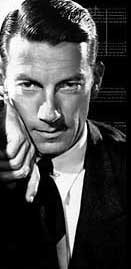
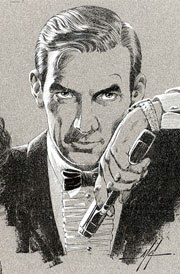
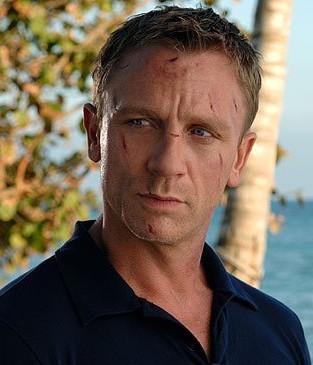
Vital Statistics
James Bond is the only child of Andrew Bond of Glencoe, Scotland, a foreign representative of the Vickers Armaments firm, and Monique Delacroix Bond of Canton de Vaud, Confoederatio Helvetica (better known as Switzerland). Bond's definite year of birth (let alone the date) is a matter of some confusion. In Moonraker (set in 1954 at the latest) it is asserted that he has only 8 years remaining before mandatory retirement at age 45, making him about 36 at the time, thus a 1918 year of birth. Little is known of his childhood, save that he spent all of it living abroad prior to the death of his parents in a climbing accident when he was 11 in the Aiguilles Rouges (Red Needles), a massif opposite Mont Blanc above Chamonix, France. This oblique reference to Chamonix and Mont Blanc is perhaps a nod to the Shelleys by Fleming. From childhood young James acquired a fluency in both French and German, which in combination with his half-Scottish, half-Swiss ancestry and Continental upbringing make him ideally suited to foreign affairs and less blatently British than the cinematic persona. On the death of his parents, James comes under the guardianship of his maiden aunt, Charmian Bond, in the village of Pett Bottom near Canterbury, who probably instills in him the fondness that he later feels toward his elderly Scottish housekeeper, May. At the age of 12 he enters Eton College, but only remains for a year due to a scandal with one of the dormitory maids (early evidence of his influence with women). His aunt then sends him to Fettes, his father's public school and a typically Scottish conservative environment (doubtless responsible for most of his curiously old-fashioned sensibilities). At Fettes, young James excels in athletics, fighting twice for the school as a lightweight and founding the "first serious Judo class at a British public school". Matriculating early at the age of 17, he undertakes a brief period of travel abroad. This would have been about 1935. During this period he learns to ski and climb (mountaineering) like a professional from a Swiss man named Hannes Oberhauser, who is for a while "something of a father" to the teenaged Bond. In 1938, with the aid of an old Vickers colleague of his father, he enters the Secret Service. M's obituary for James Bond at the close of You Only Live Twice obfuscates this part of his history, suggesting that Bond is not part of the Secret Service until 1941 and that he claims to be 19 to meet the age standard. Why M does so is unclear, but may relate to obfuscation by Fleming of his own history. Previous novels plainly establish that Bond works for the Secret Service prior to the outbreak of World War II and beginning in 1938. In his early career with the Secret Service he is a clandestine courier into Nazi Germany, Soviet Russia, and fascist Italy and Spain, the latter two sometimes by crossing high mountain passes. There is a reference to traversing Siberia by rail before the war. He spends two months in surveillance of a group of Roumanians at Monte Carlo. With the declaration of war in September 1939, James Bond is "accorded" the rank of Lieutenant in the Special Branch of the Royal Navy Volunteer Reserve (RNVR) "to serve the confidential nature of his duties". In other words, he and other Secret Service members were given plausible membership within active military organizations to conceal their clandestine activities. In reality, Section D of the Secret Service became the Special Operations Executive (SOE) and it is to this group that Bond would probably have belonged. By war's end, he rises to the rank of Commander (as did Fleming, in a similar capacity). Little is revealed of his wartime record in the stories. We know that he spent time in New York, performing an assassination of a Japanese cipher clerk with a rifle from 300 yards away in a high rise building - one of two directed kills that will result in his being assigned to the select 00 Department (the other being the liquidation of a Norwegian double agent in Stockholm). There is a passing reference to operating in neutral Stockholm (Sweden) and Lisbon (Portugal). Presumably, he spent some time with the French Resistance given his fluency, familiarity with France and association with Rene Mathis, but definitely Bond worked for a time behind enemy lines. Although we know he was in Berlin at some point in 1945, he is in Hong Kong at the end of the war later that year, following the surrender of Germany and the cessation of conflict in Europe despite the prevalence of enemy underground agents in the aftermath and concerns about Soviet influence, suggesting that Bond's talents were always to be applied at the most stressing points. Shortly after the war, Bond receives a long assignment in Jamaica, which (though never illuminated in its particulars like the rest of his wartime activities) creates a lasting love for the island colony and the Caribbean generally. After the war, Admiral Messervy is appointed the head of the Secret Service and accepts Bond's application to remain, a move that parallels the reabsorbtion of the SOE by the Secret Service in 1946. Apparently, Bond did not know or work for Admiral Messervy during the war and the Admiral's wartime career is never elucidated. It is not clear exactly when Commander Bond becomes a 00 agent, but by 1951 he is a Principal Officer in the civil service for the Ministry of Defence and the senior 00 in the small section of three 00 operatives. In 1954, he becomes a Companion of St Michael and St George (CMG) in recognition of his service to the Realm and the Crown in the events of the novel Moonraker. In keeping with Secret Service practice, this fact is not publicised until his presumed death years later. At the conclusion of The Man with the Golden Gun, near his mandatory retirement age as a 00 agent, he is offered the title of Knight Commander (KCMG), but thinks he will decline because the idea of being Sir James Bond is incompatible with his desire to eshew the public life and his own self-image of being and forever remaining a "Scottish peasant". He has at the time of Moonraker three married lovers, evidently preferring relationships that cannot progress, make small demands of him and will inevitably end. Later this seems to be much less satisfying, and we find Bond ruefully imagining the progress of a relationship, as if he has too often experienced this miserable arc of failed love. Bond is married only briefly, on 1 January 1962, to Contessa Teresa di Vicenza, daughter of the capo of the Union Corse (i.e. the Corsican Mafia), Marc-Ange Draco. The relationship ended tragically, without issue. He has about half a dozen "real friends" and no acquaintances, suggestive of an introverted personality that values intimacy over casual familiarity. In character, James Bond differs from the cinematic persona. He is far more openly emotional than any of the film interpretations, both in terms of friendly mannerisms and personal vulnerability, as evidenced by his visceral reaction to certain situations (e.g., blood everywhere and pulverized human tissue hanging like rags in the trees after a bomb blast) and profound compassion for others as well as his affection for old firends like Felix Leiter. He is not so cynical that he thinks and feels like a machine, even though there is a clear hardening of character over the course of the novels. Far from an aesthetic snob or Epicurean dillatante, he is almost Stoic in most respects. Rather than waste his winnings from Goldfinger on indulgence, he donates $10,000 to the White Cross, the SIS charity. He is a bit of a Romantic, mischievous and a schoolboy menace at heart. On the other hand, he has an astounding capacity for ruthless suppression of his own fears and suffering through sheer will. His courage also is something almost elemental, Fleming noting that it was "not in his makeup to worry" about danger and extricating himself from a situation. In fact, pressure and danger are often relaxing to him. He can be cocky in the face of horrific death. Bond finds it difficult to be anything other than himself; even when playing a role to infiltrate an organization he exudes a demeanor that is plainly too true spirited to be a good thing in a (supposed) henchman; the villains innately distrust him. In short, he is the classic British adventure hero in the tradition of Doyle, Rohmer, Oppenheimer, Haggard, etc. Personal Habits: Hobbies and RoutineBond's private passions are his Bentley (discussed hereafter), golf and gambling. He spends most of his income on his car, once "dabbled on the fringe" of the racing world and has the skill of a "Rally class" driver. He also plays golf for high stakes on the weekends at some exclusive clubs, which is an expensive hobby, and plays well enough to manage a nine handicap on some tough courses. He once mentions competing for the Dewar Trophy, a high-power rifle target shooting contest, and also shooting at Bisley with the newly adopted FN-FAL automatic rifle. In the evenings he usually plays cards or dines out at Crockford's and other fine restaurants. On a dozen or so occasions, he has accompanied Admiral Messervy as his guest to the very exclusive gentlemen's dinner club, Blades. He makes an annual pilgrimage on holiday to Royale-les-Eaux to the casino. His work schedule is typically from 10 AM to 6 PM, with luncheon in the canteen. He resides in a small flat on a plane tree-lined lane off King's Road in Chelsea with an elderly Scottish housekeeper named May. Though not expressly located within the novels, the residence is believed to lie on Royal Avenue, Markham Street or Wellington Square. The King's Road in Chelsea was then (and still is) a very fashionable locale for shopping and dining. Bond's flat is a converted Regency house having a book-lined sitting room with an Empire desk by the broad bay window and a smallish master bedroom with white and gold Cole wallpaper, deep red curtains and a dark blue counterpane on the bed. By the late 1950s, he has a direct phone line to SIS headquarters in his bedroom. Presumably there is a room occupied by May and one novel makes reference to a spare room as well. Notwithstanding the presence of his housekeeper, Bond will not tolerate being cossetted and dislikes feminine surroundings. 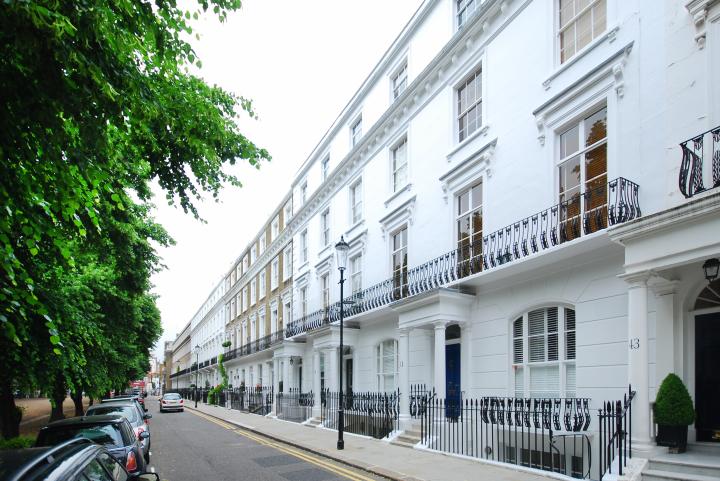
Row of Regency Townhouses in Royal Avenue on the King's Road, ChelseaWe know from his reading habits, usually books taken on travel to pass the time while in flight or on trains, that he enjoys the espionage thrillers of Graham Greene, Eric Ambler, E. Phillips Oppenheim and Somerset Maugham as well as the hard boiled private investigator tales of Raymond Chandler. This is both an homage to Fleming's own favorites and a clue to Bond's rather Romantic nature. Perhaps more surprising is his familiarity with the darker milieu of Poe, LeFanu, Stoker and Bierce. Personal Habits: Fashion & CuisineReading the books one gets the definite impression that James Bond is a lover of creature comforts and a person who takes great pleasure in the details of simple things, particularly cuisine. However, he is a civil servant, not a landed gentleman (although he inherited a modest income of about £1000 tax free and occasionally wins some money at gambling). He earns about £1500 a year and lives rather modestly when not on assignment. It is these moments of government-subsidized luxury that he relishes, partly because they are so infrequent (only two or three times a year). Rarely is Bond depicted wearing traditional evening dress (what we call a tuxedo in America). When he does, its a single-breasted dinner jacket with a thin black satin tie and a heavy silk shirt. His typical business attire is a dark blue, tropical weight, worsted wool suit, again with a heavy silk shirt but with a black knit tie. His sporting and leisure attire is either a black and white hound's tooth suit or a dark blue, short-sleeved knit shirt made of Sea Island long staple cotton. We read of the "old", "battered" and "yellowing" hound's tooth often enough to be convinced that Bond is one of those men who acquire a fondness for certain articles of clothing that approaches something of a bond of love and that he doesn't possess a deep wardrobe. Additionally, the hound's tooth suit may be another nod by Fleming to one of his favorites, in this case Conan Doyle (of course). He wears sandals when he can and hates laces on shoes. Bond's sleepwear is a long silk pyjama tunic, a habit he picked up in Hong Kong. Personal accoutrements include a flat gun-metal cigarette box in a hip pocket, containing 50 cigarettes specially made for him by Morlands of Grosvenor St. from a Balkan-Turkish blend and with three gold bands, and a black oxidized Ronson lighter. Although he occasionally smokes Chesterfields, Caporals, Lucky Strikes and Diplomates, he hates Virginia tobacco. Bond's favorite meal is breakfast, and he typically will have scrambled eggs with bacon and toast, a carafe of orange juice and coffee (he despises tea - calling it "mud" and rants that its partly responsible for the downfall of the Empire). Interspersed throughout the novels are variations on this breakfast and dinners described in succulent detail. The most memorable to me, though by no means the most elaborate, is the feast of stone crab, toast and champagne that he shares with Mr. DuPont in Goldfinger. I've made that meal and its excellent. A classic example is from Casino Royale: "I myself will accompany Mademoiselle with the caviar, but then I would like a very small tournedos, underdone, with sauce Bearnaise and a couer d'artichaut. While Mademoiselle is enjoying the strawberries I will have half an avocado pear with a little French dressing." Bond is famous for ordering a dry Vodka martini, shaken until very cold, with a twist of lemon zest, but he also drinks double gin and tonics with squeezed lime, vodka and tonic, a lot of Bourbon and various other mixed drinks. In the films, Bond is a connoissieur of Moët & Chandon Dom Perignon champagne, but the literary Bond prefers Taittinger Blanc de blancs. AutomobilesJames Bond's intrinsic nostalgia is evidenced in his choice of automobiles. At the age of 15 or so in 1933, he acquires a 1930 Bentley convertible touring coupe "almost new" with a 4.5 liter engine and the Amherst-Villiers supercharger (see the photo below) - the famous Blower Bentley (only about 55 were ever built). It is battleship grey with blue leather upholstery. During the war he has it kept in storage and it is afterward maintained "with jealous care" by a former Bentley mechanic at a local garage. Producing 175 hp (Fleming incorrectly gives it a mere 25 hp, true of the base Roll-Royce engine), it can manage better than 100 mph. By the time of its demise in Moonraker, this car is a veritable antique, but evocative of the early days of British racing ingenuity and innovation. 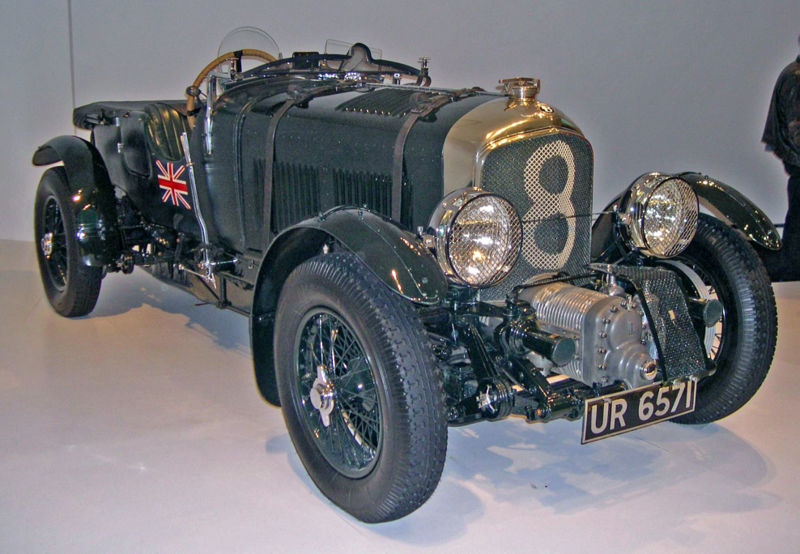
1929 Bentley 4.5 l Touring Coupe with Amherst-Villiers SuperchargerWith about £5000 of his gambling windfall, Bond purchases a new 1953 Bentley Mk VI convertible with an open touring body, also in battleship grey with dark blue leather. We glean from the test driver's suggestion that it will be tuned to make "well over the hundred" mark. Presumably he drives this car for the next several years, but it is not mentioned again. 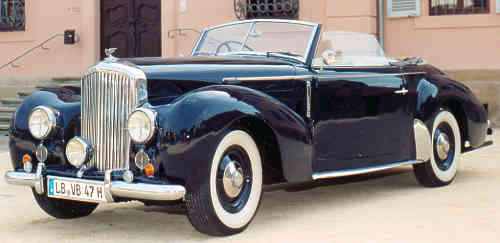
Bentley 4.5 l Mk VI CoupeFinally, in 1961, we learn that he is driving a very personalized, custom rebuilt Bentley Mk VI R-Type Continental. In addition to having an upgraded 4.9 liter engine and an Arnott supercharger controlled by a magnetic clutch, it is a two-seater convertible with completely custom coachwork by the redoubtable firm Mulliners. Gracelessly nicknamed the "Locomotive", "Bond loved her more than all the women at present in his life rolled, if that were feasible, together". The photo below is of a custom Bentley Continental with coachwork by Henri Chapron similar in concept to Bond's car. 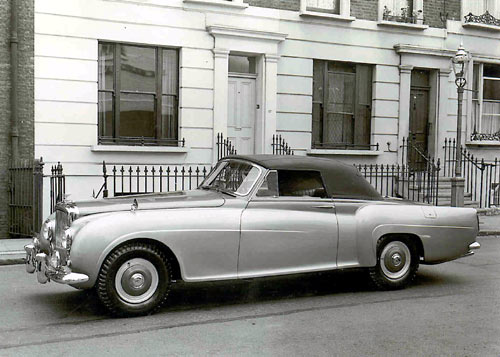
Delaisse Design Chapron Custom Bentley R-Type ContinentalGuns & GadgetsThe guns used by James Bond initially are: These guns are perfect for the period and the work. Though Fleming was criticized for giving Bond a .25 caliber, the most commonly used pistol caliber by assassins and clandestine operatives is the .22 Long Rifle rimfire, which is comparable to the .25 (6.35 mm) Browning automatic cartridge. Conspicuously, he never carries a Webley. I have concluded that this insistence on always carrying foreign manufactured firearms was part of the plausible deniability of his cover. Incidentally, although Fleming identifies the long barreled .45 Colt as an Army Special on at least one occasion, that particular model was never so chambered; in all likelihood what he intended to convey was the Colt New Service revolver. 
.25 caliber Beretta Model 1919 (418)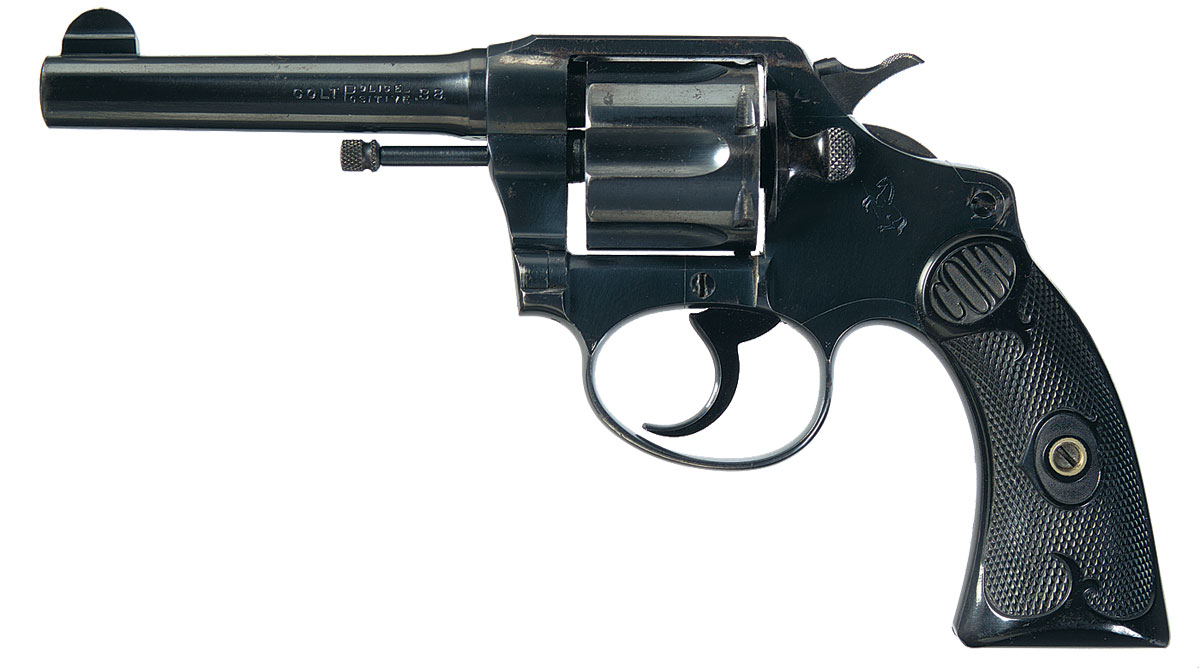
.38 caliber Colt Police Positive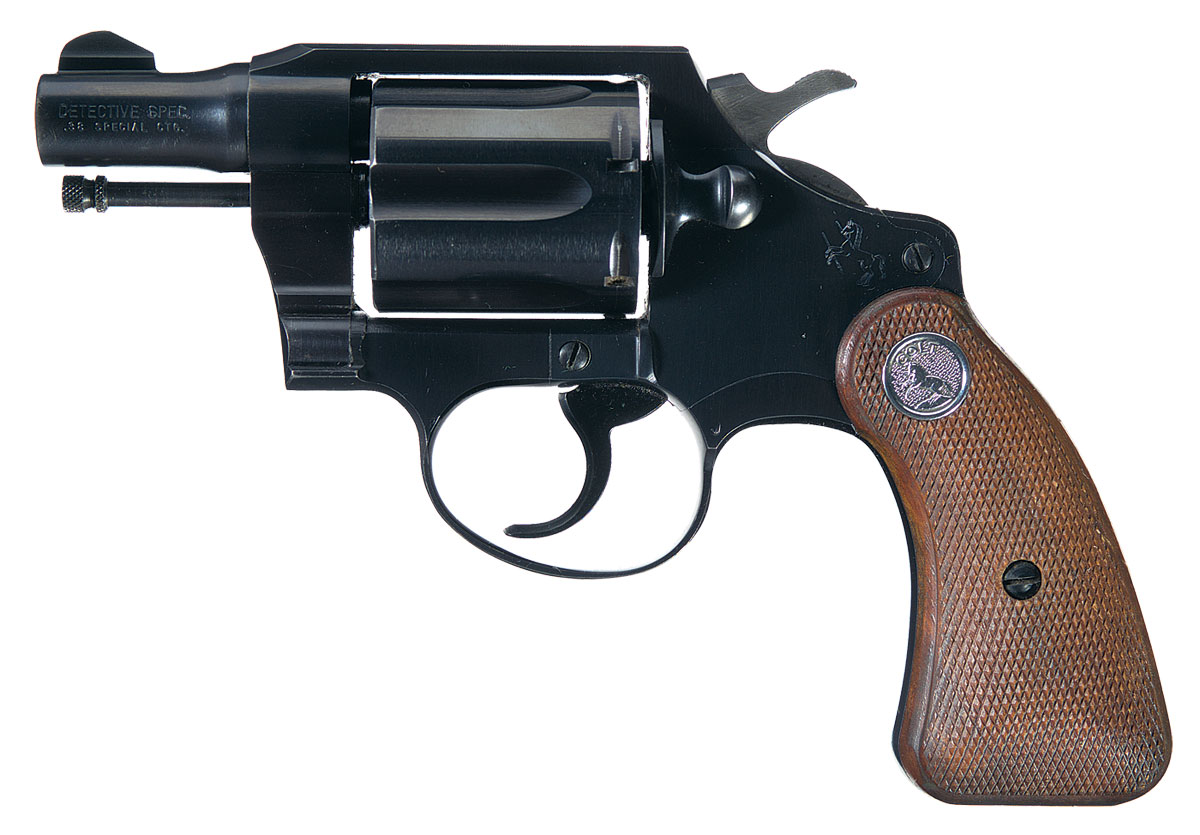
.38 caliber Colt Detective Special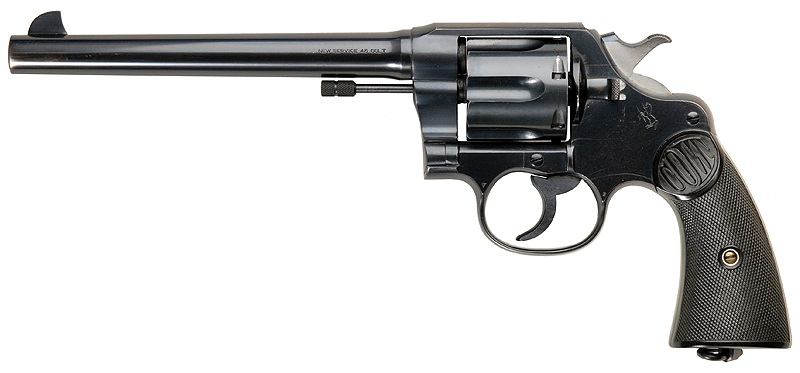
.45 caliber Colt New ServiceIn the novel Dr. No, M compels 007 to dispense with the Beretta that he has used for fifteen years and adopt a new pistol. The Armourer in the novel, a Major Boothroyd, was based on a real Geoffrey Boothroyd, who was an employee with the Imperial Chemical Industries ammunition firm and a gun writer on the subject of British sporting arms, principally shotguns. Though admitting to no personal experience in gunfighting, military arms or clandestine operations, Boothroyd wrote to Fleming chastising him for his choice of firearms in the books. Now, either Boothroyd was not such an expert on the subject of handguns or he badly confused Fleming, or both. Boothroyd decried the Beretta as a "lady's gun", failing to appreciate that its small size and reliability were its virtues - caliber being relatively unimportant. Boothroyd argued that if Bond had to use a light weapon he would be better off with a .22 rimfire because the soft lead bullet would cause more shock. Anyone familiar with my terminal ballistics pages can tell you what I think of that statement. Additionally, what made the .25 Browning cartridge so ubiquitous in early 20th century concealable pistols is its utter reliability. You would not have that with a lead nosed rimfire, and there have been very few compact .22 rimfire automatic pistols that were not technical failures. The Armourer's recommendation is for a 7.65 mm Walther PPK, to be carried in a Berns-Martin Triple Draw holster inside the waistband. The PPK is a better pistol undeniably and thereafter Bond's signature weapon, however the contention that the 7.65 mm (.32 caliber) PPK is much more powerful than the Beretta ("a real manstopper") is plainly absurd; they are insignificantly distinguishable in that respect. Were power the object, at the very least it ought to have been a 9 mm Kurz (.380 caliber) model of PPK, rather than a .32 caliber (not that there is much difference). Secondly, the Berns-Martin holster is strictly for revolvers, although that evidently was Fleming's error since Boothroyd originally campaigned for Bond to abandon automatic pistols altogether in favor of revolvers. Boothroyd also avers that the PPK has a "light trigger pull", which may be evidence that he had never handled one - it has an extremely stiff trigger pull, though not bad if cocked first. In the novel, the fictional Major Boothroyd recommends replacing the potent long-barreled .45 Colt Army Special with the diminutive .38 caliber Smith & Wesson Centennial Airweight revolver. This is where something got seriously garbled in translation. I have read all the correspondence between Boothroyd and Fleming, and he clearly communicated the proper role of this pistol to the author. The 5-shot Airweight would make an adequate carry gun as an alternative to the PPK, but its no better than the 6-shot Colts previously used by Bond and has a vicious recoil, owing to its alloy frame and awkward grip (I know, I've shot one. It was the worst recoil of any pistol that I have fired other than my .45-70 handcannon). Bond informs M at the conclusion of Dr. No that the Airweight was ineffective (which may be Fleming's subtle commentary on self-styled gun experts). In fairness to Boothroyd, the long range backup weapon recommended by the living Boothroyd was a Smith & Wesson Model 27 in .357 Magnum, which is a good choice, although Boothroyd's estimate of an effective range of 300 yards is specious. Seemingly, his preference for the .357 Magnum was it's capability to use .38 Special ammunition in a pinch, but Bond never used the big gun except in his car, so that would not have proved an advantage in practice. Ironically (since he's so keen on Smith & Wesson), Boothroyd missed the obvious opportunity to suggest the perfect heavy backup weapon for Bond in 1956: the newly introduced Smith & Wesson Model 29 in .44 Magnum caliber (see below). He alludes to it, but does not describe its characteristics. Had he done so, Fleming might have adopted it. Boothroyd's discursive perambulations regarding various pistols led Ian Fleming astray, resulting in the Armourer's assertion that the Japanese Nambu Type 14 is the best pistol in the world, based on purported testing by the USAF Ordnance Department, followed by the Tokarev. Accurate the Type 14 may be, but if you've ever seen one of these ungainly monstrosities you'll immediately comprehend my disdain; similarly, the Tokarev is a large frame service pistol and unsuitable for clandestine work. Boothroyd discussed both of these arms in the context of what may be carried by Soviet agents, but seemed to personally favor a long-barreled Luger or a Mauser Broomhandle with a shoulder stock for a putative SMERSH assassin. That sort of flourish is very literary, yet exactly the sort of thing that would be eschewed by a Soviet clandestine agent who wished to remain inconspicuous. Actual professionals do not obsess over firearms. Nor are they technical firearms experts. They are expert in the use of firearms and regard them merely as tools. This is the distinction between an enthusiast like Boothroyd, who was too young to fight in World War II and whose understanding of firearms was entirely recreational, and a person who uses firearms routinely as a weapon in deadly encounters. I have devoted more space in this essay than Fleming devotes to Bond's firearms in all of his novels. In conclusion, Fleming had a better sense, for all his unfamiliarity with firearms generally, of the types of pistols to be used in clandestine work than did Geoffrey Boothroyd, who was an enthusiast, but altogether unacquainted with the world of clandestine ops. In one of their latter exchanges, Fleming gently rebuffs Boothroyd's repudiation of silencers. Apart from the Walther PPK, none of his suggestions had a lasting impact nor were needful. 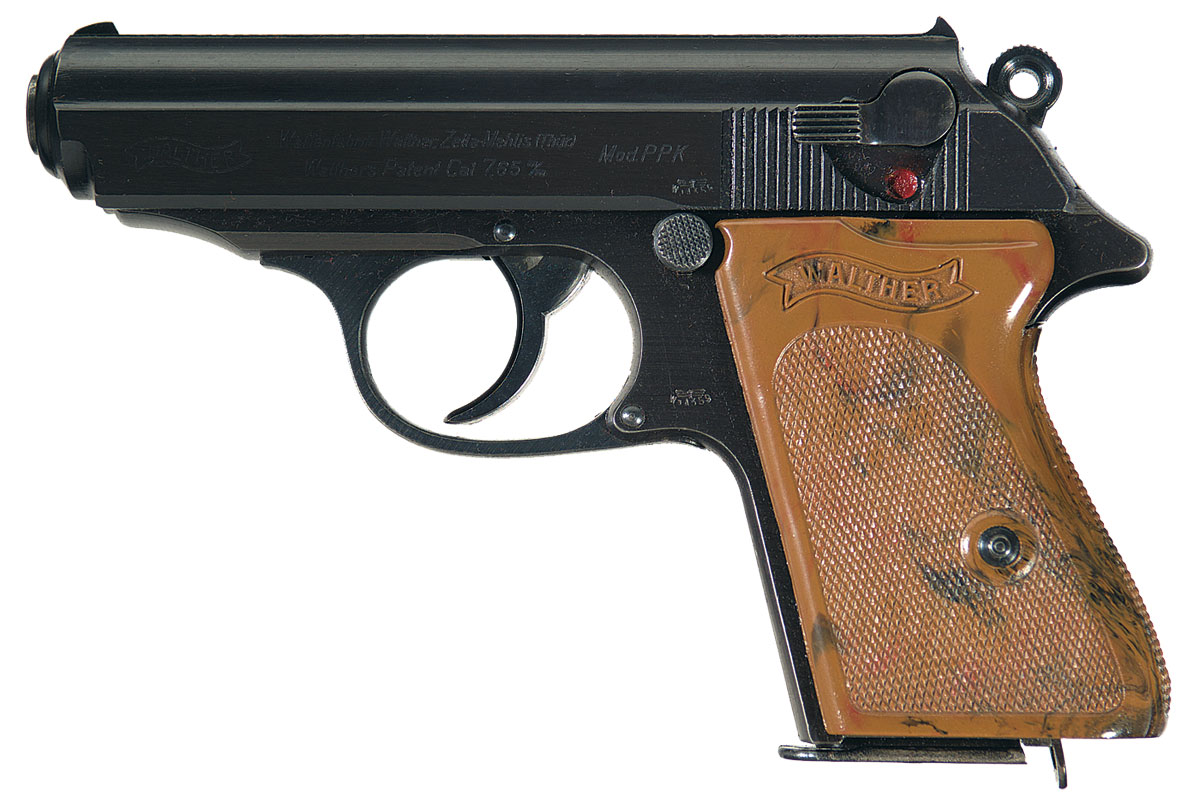
7.65 mm (.32 caliber) Walther PPK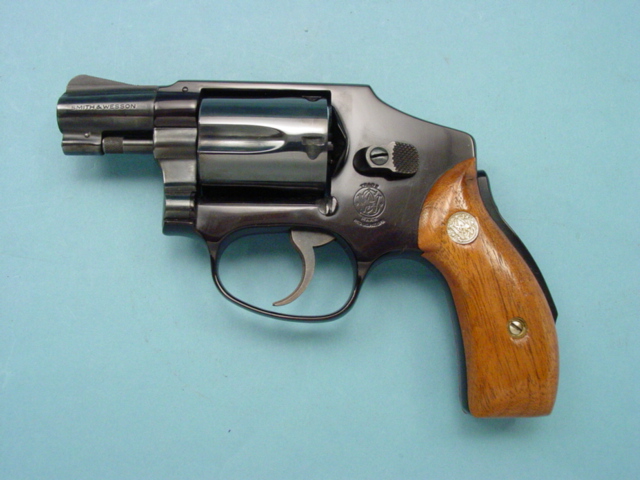
.38 caliber Smith & Wesson Centennial Airweight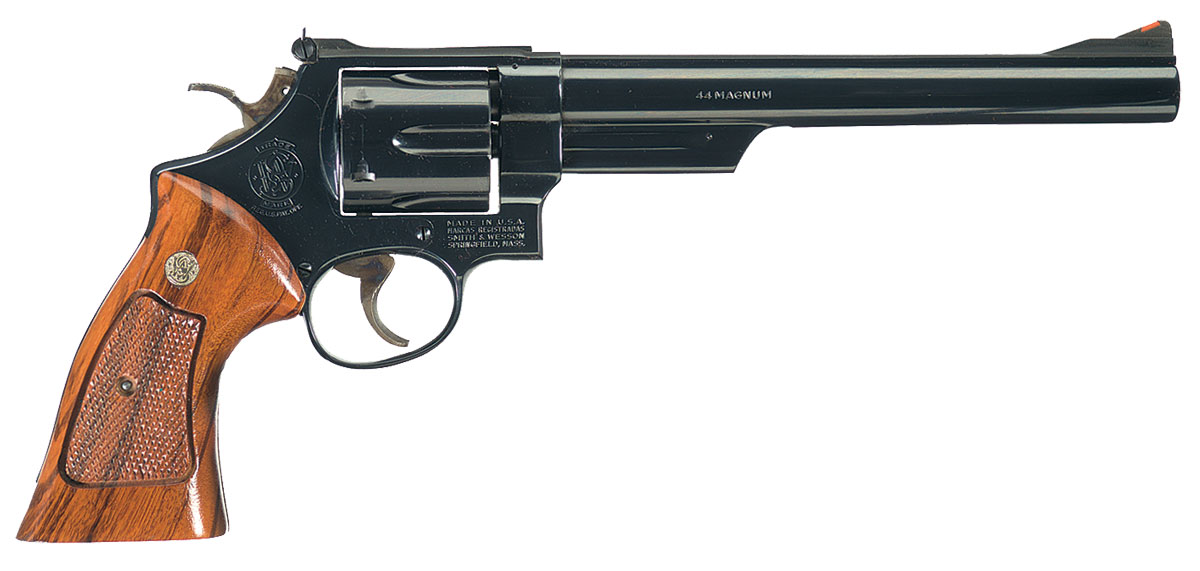
Missed Opportunity? - .44 Magnum caliber Smith & Wesson Model 29In the Fleming stories Q is not a person, its a branch of the Secret Service headquarters. Q Branch provides all of the specialized equipment used by Secret Service agents on assignment, but also arranges travel accommodations and medical care post-assignment, when required (as is often the case). Some of the more exotic equipment is actually developed by the Technical Section and only provided by Q Branch. Unlike the improbable (or impossible) gadgetry of the films, the spy-technology in Fleming's stories is very practical and often taken from actual equipment that was used by the Special Operations Executive (SOE) and the Office of Strategic Services (OSS) in World War II and MI6 and the CIA in the Cold War era. In From Russia, with Love Bond is provided a modified Swaine & Adeney attache case that hides 50 rounds of .25 caliber ammunition, 50 gold sovereigns and two Wilkinson throwing knives. It also comes with a cyanide pill in the grip but Bond immediately flushes this. Q provides a can of shave cream that hides the silencer for his Beretta. In Goldfinger for his pursuit of the titular villain, Bond draws an automobile from the motor pool, an Aston Martin DB Mk III that has some special modifications: "switches to alter the type and colour of Bond's front and rear lights if he was following or being followed at night, reinforced steel bumpers, fore and aft, in case he needed to ram, a long-barrelled Colt .45 in a trick compartment under the driver's seat, a radio pick-up tuned to receive an apparatus called the Homer, and plenty of concealed space that would fox most Customs men". No ejection seat, armor shields, oil slick and smoke projectors or machine guns... Of Her Majesty's Secret ServiceIan Fleming provides a cogent and realistic portrayal of Cold War clandestine operations. Moreover, he predicts the yet to be nascent multi-lateral world of clandestine and covert ops. Granted, as the series develops the opponents become larger than life, but where he strays into the absurd it is deliberate, invariably a bizarrerie of character, what I term the Fleming Defect - each of his villains has some perversity of form or psyche that shapes their identity. In terms of operational methods and means, the books are prosaic (at least by the standards of Cold War espionage). The British Secret Service operates "off the reservation", meaning that it is truly clandestine. Its Station Chiefs for each country or region of interest are usually covered by a plausible commercial enterprise that is legitimate, rather than operating from out of the embassy or consulate. When on an operation, Bond generally avoids the consulates and official residences (an exception being Dr. No, which begins as an ostensible routine personnel inquiry). In fact, the London office of the Secret Service is in an office building portraying itself as the home of Radio Tests, Ltd., Universal Export Co., Delaney Bros. (1940), Ltd. and The Omnium Corporation, and retains a Miss E. Twining, OBE, to answer all enquiries for any of the bogus enterprises allegedly habituated within. Fleming never refers to the Secret Service as Directorate of Military Intelligence - Section 6 or MI6, which was its identifier in World War II and still the popular convention. Bound by the Official Secrets Act, he may have been unable to acknowledge that name (initially he does a similar thing with the CIA, calling it the Combined Intelligence Agency; correcting this in Live and Let Die). Moreover, he places the headquarters of the Secret Service overlooking Regent's Park, when in fact it resided at that time on St. James Street. Nevertheless, his depiction of the organization and activities must have been fairly accurate in broad terms. He certainly reveals an astounding degree of detail concerning contemporary Soviet intelligence agencies and the actual heads of these organizations in From Russia, with Love, which makes one wonder whether his post-war contacts with the Ministry of Defence persisted. After all, and this is briefly mentioned in From Russia, with Love, the British Secret Service had very recently taken a severe blow in the defections of Burgess and MacLean and the (rightly) assumed treason of Philby. Was Fleming officially encouraged to proffer a heroic portrayal of the Secret Service? The head of the British Secret Service is known only as M, his true identity a closely held secret. In fact, M is Admiral Sir Miles Messervy, once in line to be Fifth Sea Lord of the Admiralty, but who eschewed the glories of rank for the rigors of unacknowledged dutiful service. Evidently, the actual head of the British Secret Service is traditionally known as C, after the style of Captain Sir George Mansfield Smith-Cumming, the first and very influential head of the organization who signed his office correspondence "C". Messervy, then, is a type of the real Smith-Cumming. Although I adore Bernard Lee and enjoy his portrayal of M in the early films, his relationship to 007 is often in the manner of a weary schoolmaster for an errant and precocious miscreant. Fleming's M does not relate in this way to his best agent. Indubitably, he is a classic curmudgeon, prone to moods like the sea, invariably gruff when personal matters arise, shackled by quaint Victorian sensibilities (he disapproves of Bond's "womanizing" and is embarassed by "grisly female habits"), quick to bristle over improper use of scarce service resources and possessed of an "unreasonable faith in Scots". Initially Bond is in awe of his chief, who comes to favor him almost as a son (displaying as much affection as the "Old Devil" can probably muster). In From Russia, with Love, M is depicted as the man Bond "loved, honored and obeyed", giving their relationship all the weight of a marriage, yet in the very next novel a slight arising from perceived lack of confidence by M arouses the first ever hate for him in Bond. Thereafter, their relationship is never quite as close, though M remains devoted to his protegee, so much so that he defies all established practice to rehabilitate Bond after his experience in an enemy mental conditioning program. M's car is a black Rolls Royce Silver Wraith, driven by a former Leading Stoker named Smith. Known Organization of the British Secret ServiceM's office consists of his Chief of Staff, Bill Tanner, and his personal secretary, Miss Moneypenny. Bill Tanner becomes one of Bond's best friends as the series progresses. During the war Tanner was a sapper (ie, demolitions expert), but due to an injury in 1944 he returns to Britain and serves the remainder of the war on the Secretariat to the Chiefs of Staff Committee, which oversees all military intelligence operations. It is from this association that he is recruited by M. M's office is Number 12 on the eighth floor. The remainder of the top floor is devoted to Communications. The first floor has the Records department and there is a gun range in the basement. There is a Scientific Research Section headed by Agent 501, the Chief Scientific Officer of the SIS, and a Diplomatic Section consisting of two agents. Section 100 is devoted to double agent operations. The 00 Department on the seventh floor consists of only three agents - 007, 008 (named Bill) and 0011 - an office secretary and a department head named Clements, who rarely appears in the stories. Presumably there have been six prior 00 agents before Bond and two lost between 008 and 0011 as of 1951 (though 009 is mentioned in Thunderball and a 006 in On Her Majesty's Secret Service, suggesting that the designations get reused). Little is elucidated of the other 00 agents (006 is a former Royal Marine Commando). The 00 Department secretary is not Miss Moneypenny, but rather Loelia ("Lil") Ponsonby initially and later Mary Goodnight, an ex-WREN. Much of the banter seen in the films between Bond and Moneypenny is based on his relationship with Lil Ponsonby, though once it is mentioned that Moneypenny "often dreamed hopelessly about Bond". Incidentally, the books freely use the expression "Double-O" in place of 00, despite what some have said to the contrary. Mandatory retirement age for a Double-O is 45. The 00 agents are not always sent on assassination missions, but generally when the job is difficult and unusually dangerous. They own the "licence to kill" in the sense that they have the lattitude to kill on their own discretion with the full support and confidence of Her Majesty's Government, which is an indication of their seniority and the respect accorded them. The Double-Os are given deference in choosing their assignments, which is a curious fact. Although it must be inferred, it would seem that the SIS has sections in its UK Headquarters devoted to all global regions of interest. Typically, there is also a station located in the region, perhaps several and often associated with a major city. Section S for the Soviet Union is headed in London by a tall, thin and one-armed man whose name is not given. That no Station S is ever mentioned is suggestive that no station exists as such inside the USSR (quite likely during the 1950s). Doubtless Section S has a larger than average staff, commensurate with its special significance as an area of priority. In contrast, the Caribbean and Central American Section is merely the London presence overseeing the various stations in that region. Section J for Japan is headed by a Col Hamilton. Section III seems to be Operations and oversees all field stations. There are numerous deployed stations in various regions of the globe, including in friendly countries. These station agents usually have some plausible cover for their operations. Fawcett in Jamaica is on the photo desk of the Daily Gleaner. Darko Kerim Bey in Instanbul is a spice merchant.
Miscellaneous SIS Operations & DetailsAll stations report daily at a prescribed time and frequency (e.g., 14 MHz for Station C, call sign WXN). The call sign for the London office is WWW. Thirty minutes after a missed call in, there is a Blue call (requiring a written explanation or serious reprimand), followed by a Red call 60 minutes after the scheduled call in time. After this, an emergency state is declared. Signals are conducted using Morse code rather than voice and the "hand" of the signaller is analyzed to verify the authenticity of the source. The total force of the SIS, including all stations, is estimated at about 2000 personnel and the total budget is less than 10 million pounds. We learn that a query from the field is termed an 1107 and that a field report is termed an 1806. Allies of Agent 007 and the SISBond's allies include Rene Mathis of the Deuxieme Bureau in Paris, with whom he worked (apparently) during the war. One of Bond's frequent partners on assignments is Felix Leiter of the Central Intelligence Agency (and later the Pinkerton's security firm). Leiter is a former Marine from Texas and close to Bond in age, perhaps a couple of years older. Despite losing part of an arm and a leg, he remains highly active and a capable operative. He is very lean and has a shock of straw colored hair to go with his mischievous spirit and unfaded boyish charm. M consults with a Sir James Molony, the foremost neurologist in Britain, concerning his agents. Sir James is not hesitant in warning M about the consequences of the extreme stress with which his agents cope while on operations. He is called to examine and report on 007 repeatedly. On occasion, despite the restriction against Secret Service operations in the Home territory, Bond is detailed to work with Assistant Commissioner Ronnie (later Sir Ronald) Vallance of the Special Branch of New Scotland Yard. M, ever mindful of the misuse of service resources, always resists such requests but is sometimes overruled by the PM. Vallance controls the Special Branch "Ghost Squad", an undercover special operations unit responsible for smuggling, drug trafficking and similar crimes. Fleming's ConsistencyFleming can be inconsistent with his details. At least once M's office is described as being on the ninth floor, although usually it is the eighth (possibly due to the European custom of not numbering the ground floor?), and the light above the door indicating that he is not to be disturbed can be blue, green or red (perhaps the bulb burns out...). At one point Communications is on the same floor as M, but in The Property of a Lady, Fleming asserts that the OO Section is adjacent to the Communications Section on the seventh floor. The best estimate of Bond's birthdate is 1918, but it may have been as late as 1921 (assuming he really is about 17 in 1938 when he joins the Secret Service), or even 1924 if we take the impossible allusion to his being born in the Japanese Year of the Rat (which would make him a mere child of 14 when he joined the SIS and conflict with his early history). Usually Bond's facial scar is on his right cheek, but on one occasion its on his left. In Moonraker, Fleming asserts that at the gentlemen's club Blades there are never any bills to members for dining, yet in You Only Live Twice, M pays for his lunch (maybe that covers for that atrocious Algerian wine they keep only for him?). In The Man with the Golden Gun, Bond reflects on his prior experiences in Jamaica and his time with "Honeychile Wilder" (actually Rider) - is this forgetfulness on his part, or a slip by Fleming? Bond's replacement secretary Mary Goodnight begins as a classic Fleming Girl with blue-black hair, but by the next novel she is a blonde (plausible, yet...). At times, such as when he breaks the 4th Wall with self-reference to novels about James Bond by a "former colleague", its obvious that Ian Fleming wrote these stories with a rather whimsical bit of humor that he invests in Bond as well. If he is not too concerned about his consistency, well, objecting to that is like critisizing a painter in water colors that his strokes are bleeding one into another. | ||||||||||||||||||||||||||||||||||||||||||
The James Bond Novels and Short Stories of Ian FlemingFollowing are brief synopses and highlights of the James Bond series produced by Ian Fleming in the 1950s and 60s in chronologic order. The early novels, from Casino Royale to Goldfinger are single adventures and resolve themselves by the end of the book. Then there is an interlude consisting of the short story collection, For Your Eyes Only. Four of the last five novels, Thunderball, On Her Majesty's Secret Service, You Only Live Twice and The Man with the Golden Gun, form a continuous story arc, interrupted by the rather offbeat first-person narrative The Spy Who Loved Me, ostensibly told by a woman who encounters Bond. Finally, another collection of short stories, Octopussy and The Living Daylights, dealing with events that may precede the final novel, ends the Fleming account of the adventures of Agent 007. Other authors, following Fleming's sudden death in 1964, were challenged to continue the series, notably Kingsley Amis (writing as Robert Markham) with Colonel Sun, but these efforts have never been of the quality or style of Ian Fleming. Included are the fabulous retro-styled covers by Richie Fahey for the recent US market Penguin reprints. These are the best cover art that the books have ever had and capture the period look and feel. I replaced my entire collection of Bond books when I saw these new covers by Fahey. | ||||||||||||||||||||||||||||||||||||||||||
Casino Royale (1953)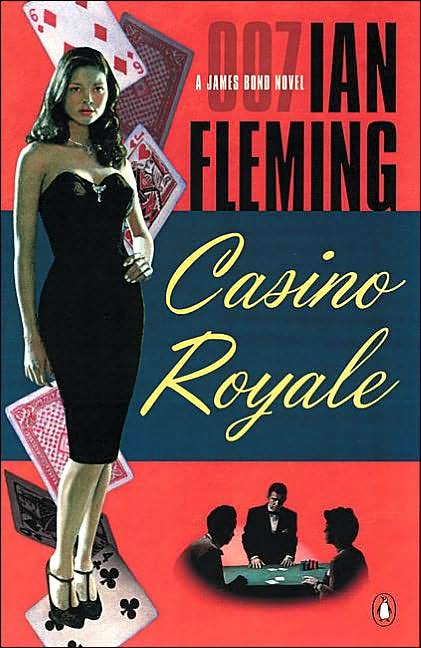
Synopsis and CommentaryAgent 007 is sent to topple a major French communist agent, who has embezzled Party funds, by beating him in a high stakes game of baccarat. Easily the most realistic of the novels, this is also one of the best - though hardcore fans of the films will be decidedly put off. This is a classic Cold War clandestine operation, in which the objective is entirely psychological and political. The drama here is very personal and though extremely intense, it is prosaic, from the gun in the back to the famous torture scene. This book is important in establishing the character of James Bond, mainly as a catalyst to drive the next several novels, but also because beliefs and issues that are suppressed and unresolved here come back later in the series. One of the things that struck me as I read this again after at least 20 years, was the emotional timbre of Bond. The cinematic Bond is rarely light-hearted, he does not smile at strangers, and he is imperturbable. Fleming's Bond is not perpetually grave, not always posing as the cold and ruthless spy. Rather, he is good-humored and friendly. More striking is his nauseated reaction to extreme gore and his evident vexation with being compelled to work with a female operative from HQ, ironically because of the anticipated sexual and emotional complications. A telling observation by Fleming: "Like all harsh, cold men, he was easily tipped over into sentiment". The extraordinary philosophizing at the finale is revelatory and utterly contrary to the picture most have of Agent 007. These things certify him as being genuinely human, rather than a machine or an improbable fiction. They also amplify the respect we have for his willpower when we consider what he is able to accomplish in spite of his emotional vulnerabilities. The cold-hearted ruthlessness is there, but it extends to his own feelings when necessary (as when subjected to torture). Vesper Lynd is also the first of what I term the Fleming Girls. She has black hair, with widely set blue eyes and a wide, sensual mouth. She wears no makeup, other than lipstick and her nails are trimmed square and have a plain varnish. Fleming (and Bond) have very definite ideas of femininity and female beauty. In the former case, women should be strong but not out in lead of the man, or involved in dangerous operations. Bond is not very progressive in his views of female roles and ascribes the softening of the British race to the dissolution of discernible gender roles. As to appearance, women should be in slight disarray (a feeling shared by one of England's great poets) and not overdone; again, evidence of a convervatism that borders on minimalism. Weapons and Spy TechnologyVillains: | ||||||||||||||||||||||||||||||||||||||||||
Live and Let Die (1954)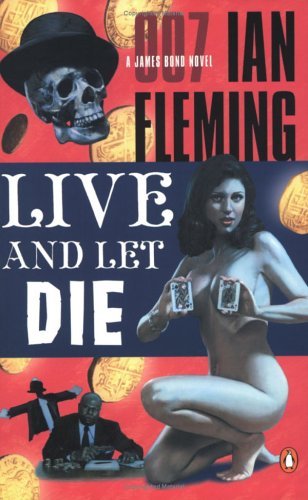
Synopsis and CommentaryAgent 007 travels to America and the Caribbean to confront a SMERSH mastermind using Voodoo terror and pirate gold to finance Soviet operations. Buonaparte Ignace Gallia (aka Mr Big) is the first Fleming super-villain, a true genius of clandestine criminal organization and one with a psychopathic ruthlessness. Having a Negro for a villain was not original in 1954, but making him brilliant and resourceful, an operator of the Soviet spy killing machine with global power, was a definite first. Gallia is also the first villain to explain himself to Bond in an air of superior confidence. That's on Fleming's part and not necessarily indicative of a contemporary sensibility; Bond is behind Leiter in terms of racial familiarity, being typically British in his affectionate yet patronizing attitude. Solitaire is another Fleming Girl. Her alliance with Bond can only be accepted as a manifestation of her ability to foresee the future and her belief in that destiny, but on that basis it is plausible. What that says about Fleming's beliefs is hard to judge; Bond often muses about morality, life and death, fate and fortune, but rarely arrives at any conclusion. Weapons and Spy TechnologyVillains: | ||||||||||||||||||||||||||||||||||||||||||
Moonraker (1955)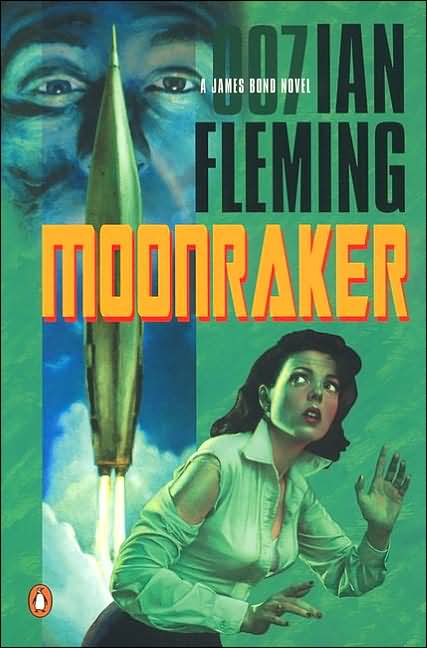
Synopsis and CommentaryAgent 007 is detailed to the Special Branch of Scotland Yard to ensure the security of a ballistic missile project and uncovers a plot of vengeance. I had never heard of this Bond novel when I first read it (the film had not been produced). It was, in fact, the first Bond novel that I read and its a good place to start, despite being the third in the series, because it begins in Secret Service HQ in London and gives the reader a rare glimpse into Bond's routine when not on assignment, including many details of the service and Bond's professional and private life. This novel introduces Assistant Commissioner Ronnie Vallance of the Special Branch and Bond's female counterpart is undercover Special Branch agent Gala Brand, another Fleming Girl and one of the stronger female characters in the series. Moonraker is one of Fleming's more inventive stories, remarkably simple in premise and yet fiendishly brilliant. For experienced bridge players, the game against Drax at Blades is marvellous. Hugo Drax is the first villain to reveal the details of his plot to Bond and the girl as he leaves them to die; this scene is the archetype for all those moments in the films. Again, we get to see the surprising range of emotions in Bond, from his rather unprofessional stealing of a kiss, to his wretching nausea out of relief that Gala isn't killed, to his willingness to die in order to prevent the Moonraker plot from succeeding. Weapons and Spy TechnologyVillains: | ||||||||||||||||||||||||||||||||||||||||||
Diamonds are Forever (1956)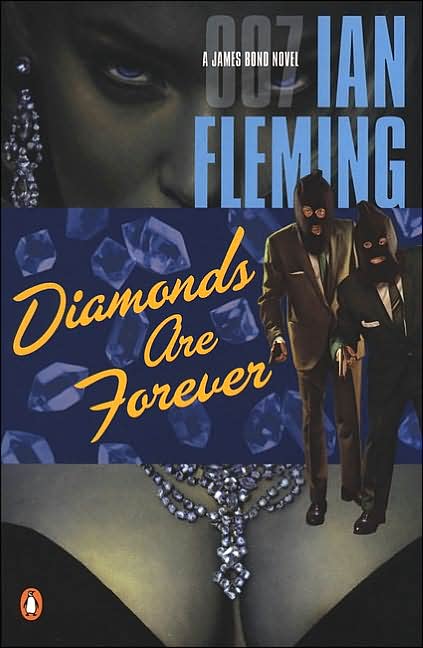
Synopsis and CommentaryAgent 007 is sent to America following an international diamond smuggling operation to destroy its leadership, the head of the Las Vegas Spangled Mob. This novel resonates today, with its origins in the black market diamond smuggling from Sierra Leone, Liberia and French Guinea. Bond is briefly teamed once more with Assistant Commissioner Vallance of Special Branch and his "Ghost Squad", and also with old ally Felix Leiter, whom he never saw again after leaving him in a hospital in Live and Let Die. Fleming's disdain for the American mafioso tough guy posturing is manifest throughout, as well as the simple-minded answer of violence to solve all problems. With 007, he seems to show that real toughness more often walks quietly and that the finality of violence can be meted out against even the "tough guys" with no difficulty. Tiffany Case is the first romantic interest to depart from the Fleming Girl pattern. She is another of his favorite types: platinum blonde, and also the first true Bond vixen, a complex good girl gone wrong. Interestingly, she is the first female interest about whom we learn something in a subsequent novel (Tiffany remains with him for many months before leaving; Bond's fling with Solitaire is apparently so brief as to require no mention). Weapons and Spy TechnologyVillains: | ||||||||||||||||||||||||||||||||||||||||||
From Russia with Love (1957)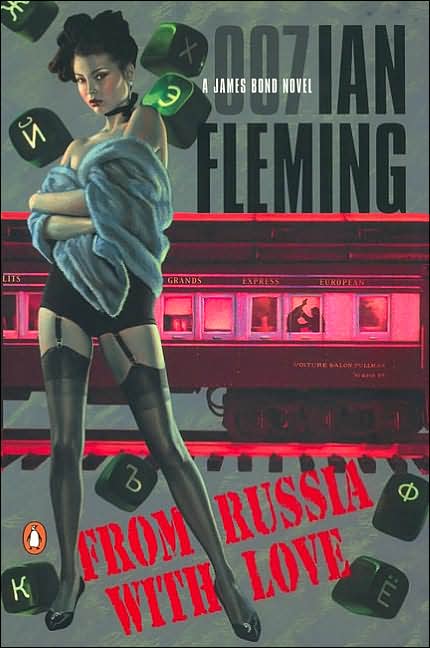
Synopsis and CommentaryAgent 007 is dispatched to escort a Soviet intelligence officer defector with an alleged infatuation with him - and an invaluable Russian cipher machine. Undeniably one of the best in the series, this story is an ingenious blending of realistic clandestine operations with the signature Fleming story elements: the beautiful woman dangerously involved in the plot, the psychotic villain with a bizarre aberration of personality and a scheme that is simple, yet extraordinary. Fleming's details of the Soviet Committee of State Security or MGB (forerunner of the KGB), Smersh and the Soviet Military Intelligence or GRU are accurate and remarkable for the time. They can only have come from official sources. I have a fair suspicion that Fleming received unofficial sanction in penning this novel, as it has a definite patriotic flair at times. There appear to be some hints at Fleming's own career in the commentary by the Russian generals regarding the "most dangerous" intelligence service in the West - the SIS - as well as the implication that the killer Grant has been trained in proper English manners by either Burgess or Maclean. Significantly, though, Bond argues for including intellectuals in the intelligence service and this is probably an oblique reproval of reactionary attitudes towards homosexuals in general after the recent fiasco (Burgess and Maclean were lovers). From Russia with Love marks the high point of Bond's relationship with M and it deteriorates pretty quickly after this. In this novel Bond "loved, honored and obeyed" M; making him truly wedded to his crusty old Admiral. M's Victorian attitudes are displayed in full splendor here and we learn that, while disapproving of Bond's womanizing, he prefers this to the prospect of Bond becoming settled as he fears losing his best operative. Certainly, this book concludes with the most remarkable final scene of any in the series. Weapons and Spy TechnologyVillains: | ||||||||||||||||||||||||||||||||||||||||||
Dr. No (1958)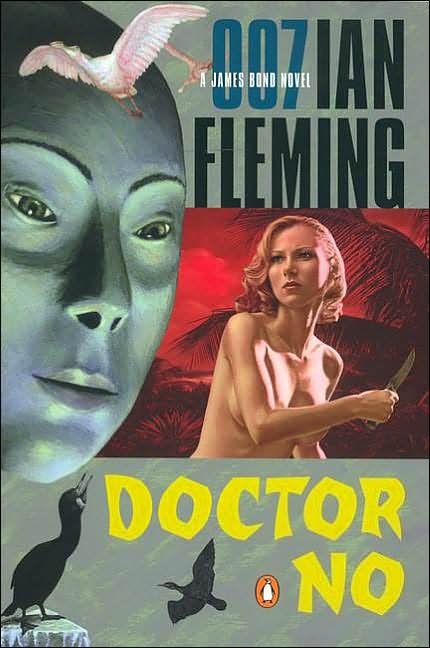
Synopsis and CommentaryAgent 007 is sent on a routine personnel inquiry and discovers a secret organization ruled by a brilliant and deadly criminal maniac. This novel is Ian Fleming's homage to the adventure novels of Sax Rohmer, creator of the criminal mastermind Dr. Fu Manchu. However, where Dr. Fu Manchu exhibits an odd sense of honor and a desire to establish a peaceful dominion of the Earth, Dr. No is more sharply drawn as a deranged fiend with a sociopathic narcissism leading to obsession with his designs and an irrational lack of comprehension of the consequences of his predilection for wanton murder. For all this he is far from flat as a character and more chillingly true to life than Rohmer's rather romantic portrayal of Fu Manchu. This is the novel that introduces Bond's famous Walther PPK pistol, replacing the Beretta that Bond has carried for 15 years. It is also the beginning of a souring of feeling by Bond for his chief, beginning with replacement of his armament and followed by assignment on an unimportant personnel inquiry, a signal (in Bond's mind) that M has lost faith in him after his hospitilization and near death in the previous assignment. Dr. No describes the routine and emergency signals operations of the SIS in some detail, including call signs and frequencies. I think that this novel provides one of the more revealing insights into Bond's character in his relationship with Honeychile Rider. Far from being exploitative, he is actually nurturing and protective - attributes that his character has rarely exhibited on film. Weapons and Spy TechnologyVillains: | ||||||||||||||||||||||||||||||||||||||||||
Goldfinger (1959)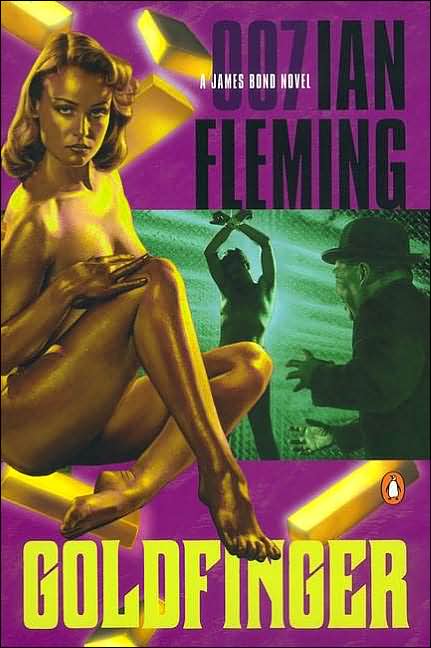
Synopsis and CommentaryAgent 007 infiltrates the organization of a ruthless criminal mastermind bent on the ultimate heist. Auric Goldfinger is arguably the penultimate nemesis of James Bond. Not only is the design of his Operation Grand Slam truly grand, but his ruthlessness is unmatched, save perhaps by Blofeld. Bond's emotional reaction to Goldfinger in the climax reveals the furious visceral outrage he feels toward this maniac who is willing to commit wanton mass murder as a mere incident to his primary object. Rarely, but on occasion, I fault Fleming's operational instincts. This novel is one of those instances. Though I have praised Goldfinger's plan for its grandness of conception, it would not have worked, primarily due to the requirement for precise timing and the use of an imprecise method of incapacitation of the populace. There are also logistical considerations, although I reckoned that Goldfinger counted on the mishaps of his conspirators in this respect to cover his own escape. The 1964 film adaptation presents a more brilliant employment of the atomic device. Weapons and Spy TechnologyAston-Martin DB Mk III with special modifications: Villains: | ||||||||||||||||||||||||||||||||||||||||||
For Your Eyes Only (1960)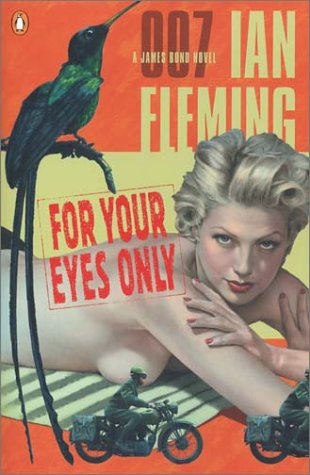
Synopsis and CommentaryThe first collection of the James Bond short stories has Agent 007 playing a deadly game to bait a team of assassins who are killing NATO couriers, hunting a former Nazi Gestapo officer as a personal favor for M, discovering the dark side of colonial life in the Bahamas, pursuing the heroin traffic to a nest of smugglers in Italy and facing a psychopathic millionaire on a private yacht in the Indian Ocean. While three of these tales are espionage adventure stories in the style of the Fleming novels, two are quite unusual, especially Quantum of Solace, in which Bond is not involved (except for a brief reference to the thermite grenades he has just thrown into the holds of two arms smugglers' boats) and the story is a recounting of a torrid, shocking affair and the husband's cold hearted revenge. The other doesn't involve espionage, though it features a villain very much in the Fleming mold. Each of these seems to suggest that ordinary life can be as precarious as the adventurous life of a secret agent and also serve to give us a view of James Bond in a different context than we normally observe in the novels while he is on assignment. Weapons and Spy TechnologyVillains: | ||||||||||||||||||||||||||||||||||||||||||
Thunderball (1961)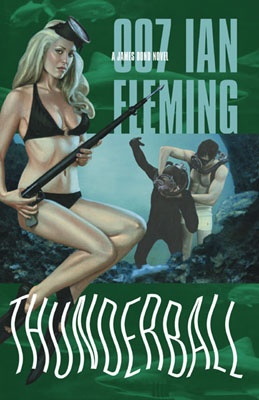
Synopsis and CommentaryAgent 007 races against the clock to discover the clues to a terrorist organization known as SPECTRE that has stolen two atomic bombs and is blackmailing NATO. This novel pits Bond against Ernst Stavro Blofeld for the first time and begins a four-novel story arc that culminates in the final Bond novel written by Ian Fleming. Where the films make SPECTRE a centerpiece of the cinematic legend, Fleming has it exposed and ruined by novel's end. Operation Thunderball has a plausibility and significance that resonates as loudly today as in 1961 and is one of Fleming's more brilliant conceptions. This is the first departure from a strictly Cold War, East versus West kind of scenario and presages an emerging multi-lateral world. This story reunites Bond with his old ally Felix Leiter, once again with the CIA. Weapons and Spy TechnologyVillains: | ||||||||||||||||||||||||||||||||||||||||||
The Spy Who Loved Me (1962)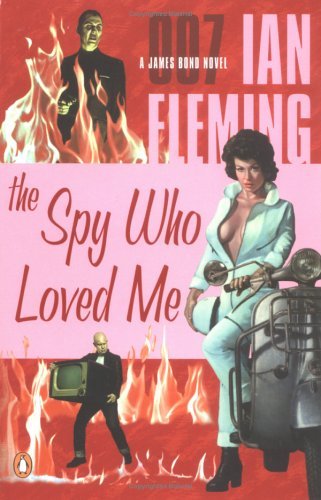
Synopsis and CommentaryA young French Canadian woman recounts her adventures, including her brief job as a caretaker to a remote roadside motel in upsate New York where she is menaced by mobsters until the unforeseen arrival of a British stranger... Easily the most unusual of Fleming's novels, this is told entirely from the first person viewpoint of the young woman, Vivienne Michel. Apart from the action involving two American thugs, Bond tells her of his recent adventures since Operation Thunderball. One of the interesting aspects of this novel is Bond's manner toward Vivienne Michel - he is very much in the classic British hero mold here, without any of the hard edged cynicism of the Cold War spy. He's good humored, bouyant, kind and encouraging to a frightened young woman in a horrific situation. He seems to be in perfect control even when things don't go as planned; this unflappability is an aspect of character that the films adopted, but in a distorted sense with a smarmy sort of dark humor that is not present in the novel. Weapons and Spy TechnologyVillains: | ||||||||||||||||||||||||||||||||||||||||||
On Her Majesty's Secret Service (1963)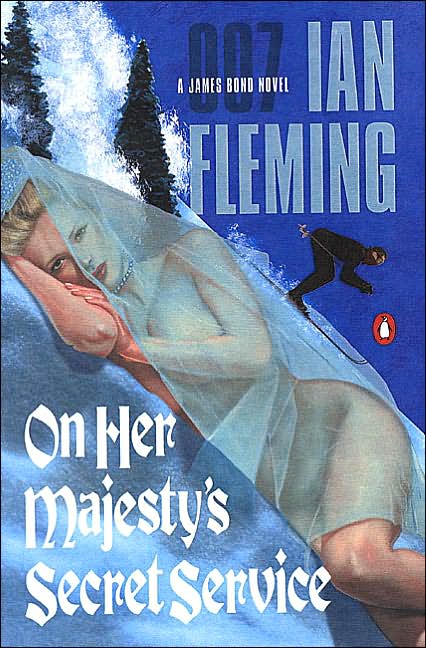
Synopsis and CommentaryAgent 007 follows an unlikely lead to discover whether a researcher into allergies who believes he is the legitimate Compte de Bleauchamp may in fact be the same Blofeld who was the head of SPECTRE, reponsible for the nuclear blackmail threat behind Operation Thunderball. Along the way he becomes involved against his better judgment with the daughter of the Capu of the Corsican mafia and uncovers a plot of fiendish ingenuity. This is a particularly interesting novel in the series. It bears certain similarities to Casino Royale in its soul-searching, moments of personal crisis and in that James Bond falls in love and thinks of retiring from the world of espionage to lead a normal life. Its also the second novel in the four-novel story arc that describes Bond's conflict with Blofeld and its aftermath. Bond is almost a rogue agent in this story; he swings from ennui and rebellion to the point of resignation to the other extreme of unauthroized ops and a near obsession to get his man. Weapons and Spy TechnologyVillains: | ||||||||||||||||||||||||||||||||||||||||||
You Only Live Twice (1964)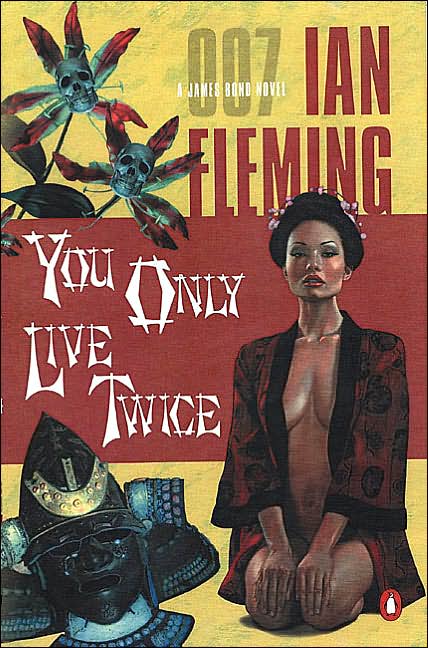
Synopsis and CommentaryBurned out and clinically depressed, James Bond is sure of being fired when M decides to reassign him as Agent 7777 of the Diplomatic Section, detailed to Japan with the mission of forming a strategic alliance with the head of the Japanese Secret Service in order to gain access to highly coveted Soviet signals intelligence. After the tragic conclusion of the preceding novel this tale reads like a journey of the soul and a story of re-birth (apropos of the haiku quoted in the title). Bond is lost and without aim, but at the same time he is open to any new direction, especially if it helps him to forget the past. The brief time he spends with the primitive Ainu fishing people at the conclusion of this novel is revelatory not only of the James Bond that has been suppressed by his profession, but also of the still burning core of that persona that sends him on in quest of his forgotten past and unknown future. Weapons and Spy TechnologyVillains: | ||||||||||||||||||||||||||||||||||||||||||
The Man with the Golden Gun (1965)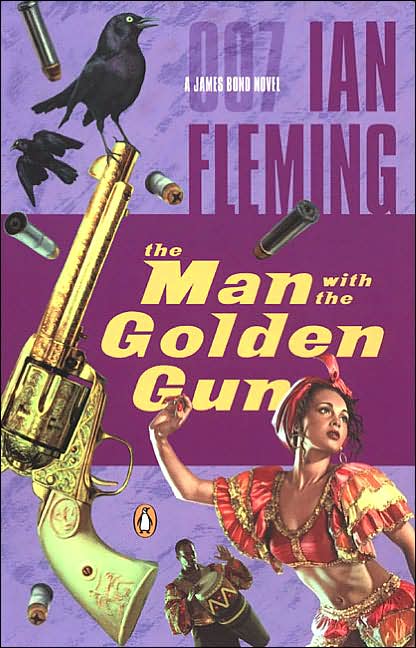
Synopsis and CommentaryJames Bond unexpectedly reemerges at the headquarters of the SIS after long being thought dead and is sent on a suicide mission by M as an act of propiation and redemption that will restore his reputation in the Secret Service and justify M's enduring confidence in his best agent: Bond must seek out and kill the deadliest assassin in the world. The final chapter of the four novel story arc that began with Thunderball, this novel traces Bond from his lowest point to a resurgent 007 at the peak of his abilities. It is a fitting finale to the series because we see Bond reborn and returned to the optimism and enthusiasm for his work and for life that he displayed in the early novels of a decade before. Before that point there is a story that plays out mainly on the psychological plane, in that it involves little action until a highly dramatic denoument. This interplay between Bond and Paco Scaramanga renders in stark contrast the differences between the sociopathic and psychopathic urges of a killer with a deranged infantile mind and the psychology and philosophy of our straight up British hero, whose reluctance to kill in business-like cold blood could be easily misunderstood as some sort of Victorian scruple or a weak stomach for murder, but which in fact is a manifestation of his personal curiosity for the man he is pitted against and a frame of mind best described as that of a sporting hunter for the game. Bond won't kill Scaramanga when he can easily do it because that would deny himself the full experience of the hazard and the challenge. His horror at killing the wounded and unarmed Scaramanga arises from a loss of interest in the game; it is concluded, over, and he has won, but to finish his opponent thusly has a disagreeable character that diminishes from the hunt. Weapons and Spy TechnologyVillains: | ||||||||||||||||||||||||||||||||||||||||||
Octopussy and the Living Daylights (1966)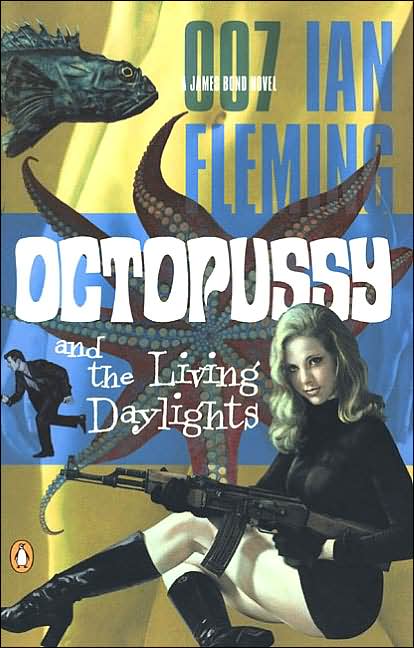
Synopsis and CommentaryThe final collection of the James Bond short stories, published postumously, finds Agent 007 ferreting out a decorated war hero who was in truth a murderer and thief while serving in a special unit under the oversight of the SIS at the end of the Second World War, assigned to West Berlin as a counter-sniper in a deadly game of seconds to cover the crossing over a fellow SIS agent whose imminent escape has been given to the best Soviet sniper to prevent, and bidding for a rare Faberge egg at Sotheby's in order to expose the top KGB officer in the UK. Some editions also include a whimsical travelogue entitled "007 in New York", describing Bond's miseries in US Customs (pre-9/11!) and mental planning for better experiences on the town. Although published after The Man with the Golden Gun, the stories deal with events that transpire years earlier, specifically in 1960 for The Living Daylights, 1962 for Octopussy and 1963 or later for The Property of a Lady. These tales are all good and while, like other Bond short stories, they do not all involve much action by Bond they do elucidate his character and provide details of his life and work that are absent from the novels. The Living Daylights is a case of technical contrasts; fine accuracy on the one hand with Bond's armament and training and a rather inexplicable choice by Fleming of an AK-47 Kalashnikov rifle for his Soviet sniper. Weapons and Spy TechnologyVillains: | ||||||||||||||||||||||||||||||||||||||||||
The Canonical James Bond Novels by Other AuthorsFollowing are brief synopses and highlights of selected novels in the canonical James Bond series authorized by Glidrose Publications, Ltd (now Ian Fleming Publications, Ltd) to follow the works of Ian Fleming after his death. Kingsley Amis, John Gardner, Raymond Benson and Sebastian Faulks have been tapped in succession to wear the mantle and continue the canon. Additionally, Charlie Higson has written authorized novels about Bond's adventures as a teenager. | ||||||||||||||||||||||||||||||||||||||||||
Colonel Sun (1968) by Kingsley Amis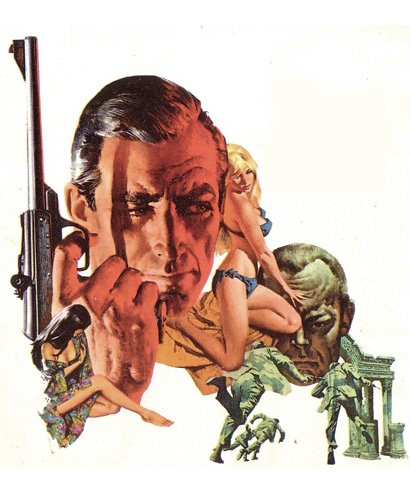
Synopsis and CommentaryWhen M is kidnapped by an unknown organization, 007 is despatched on a mission of national urgency and private vendetta to the Greek isles. Bond's adversary is a psychopath with a fascination for torture, COL Sun Liang-tan of the Chinese People's Liberation Army (PLA) Special Activities Committee, who has a plot to ravage the British Secret Service while deepening the conflict between the Western powers and the Soviets. Following the early death of Ian Fleming in 1964, literary notable Kingsley Amis was approached by Glidrose Publishing to write a new Bond novel, which he did under the pseudonym Robert Markham. Though published in 1968, the story is set in 1965 and intended to follow closely on the action of the last of Fleming's work. Colonel Sun is quite well written, very much in the style of Ian Fleming, which, perhaps, should come as no surprise since Kingsley Amis was one of Fleming's close friends and a collaborator on Fleming's last Bond novel, The Man with the Golden Gun. The strongest elements of this novel are the characterization of Colonel Sun Liang-tan and the rather intense torture scene near the end. While offering the basic elements of a good plot (admittedly reminiscent of From Russia with Love) and the cultural sensibilities of Fleming, Amis lacks the appreciation for secret operations and tactics that Ian Fleming possessed and at times it really shows. Specifically, the novel is weakened by Amis' efforts to show the resourcefulness and gritty heroism inherent in Fleming's iconic character by depriving him of his weapons, tools, SIS support, etc - a worthy object and he does achieve his aim. Unfortunately, the clumsy means employed by Amis to achieve this state of isolation and helplessness result in Bond acting in a manner that that is totally out of character and contrary to common sense simply because Amis needs a plot contrivance. Bond would never risk the safety of his chief or the interests of the realm by going after Colonel Sun alone and without making any effort at contacting his HQ, apprising them of the situation. Initiative and independence aside, he would have reckoned on the possibility of his failure and left some means of followup. Additionally, a quick phone call to the Russian consulate in Greece would have effectively neutralized the whole plot by Sun, leaving only the rescue of M to be undertaken. Overall, while capturing much of the style and manner of Fleming's work, the book lacks his humor, wit and sensibility, with the result that Bond seems a bit dull and dry at times, for no apparent reason (Fleming made him dull and dry at times, but we always knew it was intentional, and why). Despite its flaws, Colonel Sun is the best of the Bond novels written after Fleming. There was a plan to make a film adaptation, but allegedly it was blocked by Harry Saltzman because Glidrose had rejected Per Fine Ounce, what would have been the first post-Fleming continuation novel. Weapons and Spy TechnologyVillains: | ||||||||||||||||||||||||||||||||||||||||||
License Renewed (1981) by John Gardner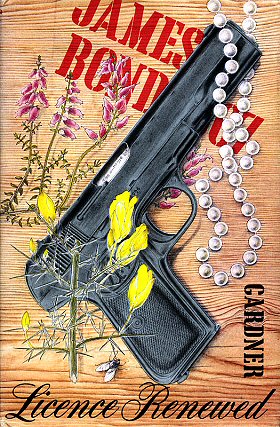
Synopsis and CommentaryDespite the abolishment of the 00 Section, James Bond remains in the SIS as M's most trusted special operative. He is sent to investigate a Scottish nuclear physicist, Dr. Anton Murik, Laird of Murcaldy, lately expelled from the Atomic Energy Commission for his alarming views on nuclear design safety, and who has become involved with a notorious international terrorist to the worry of the British Government. John Gardner's depiction of James Bond owes much more to the film series than to the writings of Ian Fleming, beginning with his decision to update Bond to contemporary time (ie, the 1980s) without serious regard for the implications; namely what conceivable use would the SIS have with a sixty-year-old 00 agent - a full 15 years past mandatory retirement age? Or if, as some have concluded, we are to believe that the preceding 15 or so years never happened, then the whole of Bond's career must be assumed to have occurred in the late 1960s and 70s instead of the 1950s and early 1960s, which throws the entire history out the window. Gardner takes liberties in other respects as well. He replaces 007's compact Walther PPK with a Browning P-35 High Power, a 9 x 19 mm caliber full size service pistol that would be essentially impossible to conceal except under a loosely fitted suit. To his credit, he gives Bond a Ruger Super Blackhawk .44 Magnum as a backup gun. More shockingly, he has Bond abandon his passion for vintage cars, and Bentleys in particular, for a tricked out Saab 900 turbo; something that the fiercely and quaintly patriotic Bond would never have done. On the right is the first edition cover artwork by Richard Chopping. Weapons and Spy TechnologyCustom Saab 900 Turbo: John Gardner wrote 14 original Bond novels in all before passing the torch. His third novel, Icebreaker, is generally regarded as his best. I have not read it, but may one day and will report my findings. | ||||||||||||||||||||||||||||||||||||||||||
Zero Minus Ten (1997) by Raymond Benson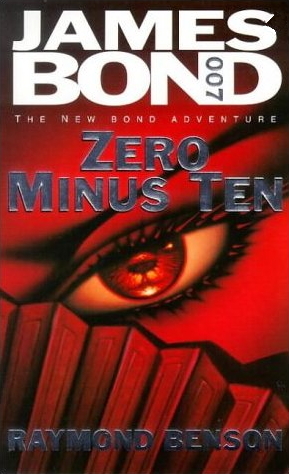
Synopsis and CommentaryIn the days leading up to the hand over of the British colony of Hong Kong terrorist incidents lead to heightened tensions between Britain and China, seemingly stemming from the mysterious dealings of the heir of a legacy colonial trading house, Guy Thackerey, and agent 007 is sent to uncover the threats before they precipitate a war. Zero Minus Ten was Raymond Benson's first James Bond novel. Previously a Bond fan and author of The James Bond Bedside Companion, Benson apparently obtained the privilege of penning the next canonical James Bond novel on the premise that his knowledge of the character and story details made him the perfect man to carry on the legacy in a manner both respectful and faithful to the original efforts of Ian Fleming. I will say that Benson's story is original and entertaining. However, his writing abilities are merely adequate; he lacks the wit and charm of Fleming. Then, there is the same issue that existed with Gardner's novels, in that as this story is set in the current time (of necessity), that would make Bond 76 years old! Yet, Benson seems to acknowledge Bond's Cold War history while stating that he has just a "touch of gray", suggestive of a fit 40-something. Its as if the intervening three decades never happened. Like Sherlock Holmes, James Bond is a creature of his time and there is just no good way to update him without doing violence to the canon. Worse, Benson's characterization of Bond not only follows the films as opposed to Fleming's writings (including some things that seem rather out of character, such as the readiness with which Bond has sex with a prostitute and his utter disregard for the consequences of his mayhem in the People's Republic), but he makes so many gross mistakes of operational craft that it comes across as exceptionally amateurish. For example, Benson has the Hong Kong Station chief meet Bond at the airport, Bond makes calls directly to SIS headquarters over non-secured lines to discuss operational matters in the clear, and even after the safe house (which is merely the residence of the station chief) is compromised, Benson has M order Bond to go back there and wait further instructions; on and on it goes, and at one point, ironically, Benson has the local Triad ganglord reveal the ease with which he made Bond as a British agent because of these clumsy methods, but somehow he fails to appreciate the obviousness of it. I thought of reading Benson's final Bond novel (which I had until I inadvertently left it in a hotel room) to see how much his form improved, but I'm not sure its worth my time. | ||||||||||||||||||||||||||||||||||||||||||
Devil May Care (2008) by Sebastian Faulks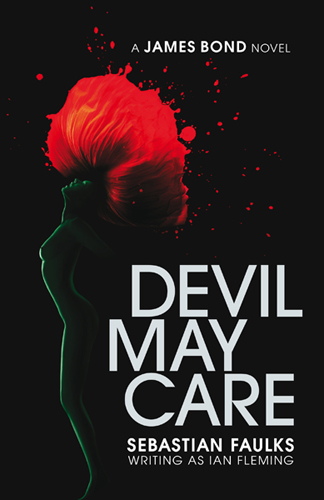
Synopsis and CommentaryJames Bond is sent to investigate a French pharmaceutical manufacturer who may be involved in the narcotics trade, and discovers that he has an even grander scheme to embroil the UK and the USSR in a global conflict. Given that Faulks is billed as "writing as Ian Fleming", that is to say, literally attempting to mimic Fleming's prose style, it is either ironic or perhaps a Freudian slip that he seems rather to be mocking Fleming. Devil May Care reads more like a spoof of Fleming's novels than a newly discovered lost novel (Faulks condescendingly stated that asking him to pen the novel was "...like asking someone who writes complex, symphonic music to write a pop song", The Sunday Times, 7 June 2008). Numerous plot points are more of a rehash of old characters and plot lines than original material, notably from Moonraker and Goldfinger: the tennis match with Gorner, the Asian henchman Chagrin, the stolen nuclear weapon, etc. Additionally, Bond, M and all the familiar characters are out of character here. Someone has aptly described this novel as the literary equivalent of Die Another Day, the most abysmal of all the 007 films by far. All of which simply demonstrates that more than mere mechanical ability is needed to mimic a writer, respect for the material is also necessary, and that commissioning a high brow literateur to take on such a task in honor of Fleming's centenary was not such a good idea. | ||||||||||||||||||||||||||||||||||||||||||
DisclaimerThe views expressed herein are those of the author. No liability is assumed for any misapprobation of intent or injury to persons or entities, either actual or alleged, by the content of this site. This is a non-commercial site maintained at the author's expense as a tribute to these works of fiction. All imagery exhibited at this site is assumed to be unrestricted and will be removed at the request of authorized entities upon presentation of proof of copyright (although it would well behoove such parties to consider the advantage to be gained by refraining from molesting honest efforts at praise and sponsorship).Originally posted 26 March 2011 -- All rights reserved |